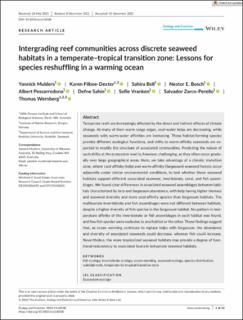| dc.description.abstract | Temperate reefs are increasingly affected by the direct and indirect effects of climate change. At many of their warm range edges, cool-water kelps are decreasing, while seaweeds with warm-water affinities are increasing. These habitat-forming species provide different ecological functions, and shifts to warm-affinity seaweeds are expected to modify the structure of associated communities. Predicting the nature of such shifts at the ecosystem level is, however, challenging, as they often occur gradually over large geographical areas. Here, we take advantage of a climatic transition zone, where cool-affinity (kelp) and warm-affinity (Sargassum) seaweed forests occur adjacently under similar environmental conditions, to test whether these seaweed habitats support different associated seaweed, invertebrate, coral, and fish assemblages. We found clear differences in associated seaweed assemblages between habitats characterized by kelp and Sargassum abundance, with kelp having higher biomass and seaweed diversity and more cool-affinity species than Sargassum habitats. The multivariate invertebrate and fish assemblages were not different between habitats, despite a higher diversity of fish species in the Sargassum habitat. No pattern in temperature affinity of the invertebrate or fish assemblages in each habitat was found, and few fish species were exclusive to one habitat or the other. These findings suggest that, as ocean warming continues to replace kelps with Sargassum, the abundance and diversity of associated seaweeds could decrease, whereas fish could increase. Nevertheless, the more tropicalized seaweed habitats may provide a degree of functional redundancy to associated fauna in temperate seaweed habitats. | en_US |
